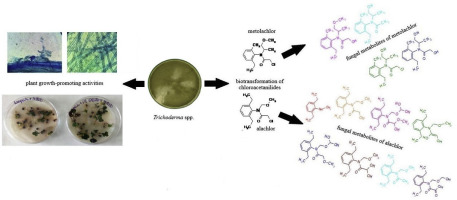当前位置:
X-MOL 学术
›
Pestic. Biochem. Phys.
›
论文详情
Our official English website, www.x-mol.net, welcomes your
feedback! (Note: you will need to create a separate account there.)
Biotransformation and detoxification of chloroacetanilide herbicides by Trichoderma spp. with plant growth-promoting activities
Pesticide Biochemistry and Physiology ( IF 4.2 ) Pub Date : 2020-02-01 , DOI: 10.1016/j.pestbp.2019.11.018 Justyna Nykiel-Szymańska 1 , Przemysław Bernat 1 , Mirosława Słaba 1
Pesticide Biochemistry and Physiology ( IF 4.2 ) Pub Date : 2020-02-01 , DOI: 10.1016/j.pestbp.2019.11.018 Justyna Nykiel-Szymańska 1 , Przemysław Bernat 1 , Mirosława Słaba 1
Affiliation

|
Due to the increasing use of chlorinated organic compounds, environmental pollution is a key issue in agricultural and industrial areas. In this study, biodegradation of chloroacetanilide herbicides, such as alachlor and metolachlor, by eight fungal strains of Trichoderma spp. originating from different microorganism collections was investigated. The tested fungi converted 80-99% of alachlor and 40-79% of metolachlor after 7 days of incubation. Biotransformation of herbicides was performed mainly by dechlorination and hydroxylation reactions. Eight alachlor metabolites and four byproducts of metolachlor conversion were detected in Trichoderma cultures, including two metolachlor intermediates for the first time identified in fungi. Moreover, in the cultures of six Trichoderma strains supplemented with chloroacetanilides, a decrease in toxicity was observed toward tested Artemia franciscana crustaceans. Simultaneously, 7 days after the application of the spores of T. koningii IM 0956, T. citrinoviride IM 6325, T. harzianum KKP 534, T. viride KKP 792 and T. virens DSM 1963 the length of roots and shoots of rapeseed seedlings treated with alachlor or metolachlor significantly increased. All tested strains exhibited plant growth-promoting traits, such as siderophore production, 1-aminocyclopropane-1-carboxylate deaminase (ACCD) activity, and phosphate solubilization, even in the presence of chloroacetanilide herbicides.
中文翻译:

木霉属对氯乙酰苯胺类除草剂的生物转化和解毒作用。具有促进植物生长的活动
由于氯化有机化合物的使用越来越多,环境污染是农业和工业领域的一个关键问题。在这项研究中,八种木霉属真菌菌株对氯乙酰苯胺类除草剂(如甲草胺和甲草胺)的生物降解。对来自不同微生物集合的进行了研究。被测试的真菌在培养 7 天后转化了 80-99% 的甲草胺和 40-79% 的甲草胺。除草剂的生物转化主要通过脱氯和羟基化反应进行。在木霉培养物中检测到八种甲草胺代谢物和四种甲草胺转化的副产物,其中包括首次在真菌中发现的两种甲草胺中间体。此外,在补充有氯乙酰苯胺的六种木霉菌株的培养物中,观察到对测试的卤虫甲壳类动物的毒性降低。同时,在施用科宁木虱 IM 0956、柑橘木虱 IM 6325、哈茨木霉 KKP 534、绿色木霉 KKP 792 和绿色木霉 DSM 1963 的孢子后 7 天,处理油菜的根和幼苗的长度用甲草胺或异丙甲草胺显着升高。即使在氯乙酰苯胺除草剂存在的情况下,所有测试菌株都表现出促进植物生长的特性,例如铁载体产生、1-氨基环丙烷-1-羧酸脱氨酶 (ACCD) 活性和磷酸盐增溶作用。virens DSM 1963 用甲草胺或异丙甲草胺处理的油菜籽幼苗的根和芽的长度显着增加。即使在氯乙酰苯胺除草剂存在的情况下,所有测试菌株都表现出促进植物生长的特性,例如铁载体产生、1-氨基环丙烷-1-羧酸脱氨酶 (ACCD) 活性和磷酸盐增溶作用。virens DSM 1963 用甲草胺或异丙甲草胺处理的油菜籽幼苗的根和芽的长度显着增加。即使在氯乙酰苯胺除草剂存在的情况下,所有测试菌株都表现出促进植物生长的特性,例如铁载体产生、1-氨基环丙烷-1-羧酸脱氨酶 (ACCD) 活性和磷酸盐增溶作用。
更新日期:2020-02-01
中文翻译:

木霉属对氯乙酰苯胺类除草剂的生物转化和解毒作用。具有促进植物生长的活动
由于氯化有机化合物的使用越来越多,环境污染是农业和工业领域的一个关键问题。在这项研究中,八种木霉属真菌菌株对氯乙酰苯胺类除草剂(如甲草胺和甲草胺)的生物降解。对来自不同微生物集合的进行了研究。被测试的真菌在培养 7 天后转化了 80-99% 的甲草胺和 40-79% 的甲草胺。除草剂的生物转化主要通过脱氯和羟基化反应进行。在木霉培养物中检测到八种甲草胺代谢物和四种甲草胺转化的副产物,其中包括首次在真菌中发现的两种甲草胺中间体。此外,在补充有氯乙酰苯胺的六种木霉菌株的培养物中,观察到对测试的卤虫甲壳类动物的毒性降低。同时,在施用科宁木虱 IM 0956、柑橘木虱 IM 6325、哈茨木霉 KKP 534、绿色木霉 KKP 792 和绿色木霉 DSM 1963 的孢子后 7 天,处理油菜的根和幼苗的长度用甲草胺或异丙甲草胺显着升高。即使在氯乙酰苯胺除草剂存在的情况下,所有测试菌株都表现出促进植物生长的特性,例如铁载体产生、1-氨基环丙烷-1-羧酸脱氨酶 (ACCD) 活性和磷酸盐增溶作用。virens DSM 1963 用甲草胺或异丙甲草胺处理的油菜籽幼苗的根和芽的长度显着增加。即使在氯乙酰苯胺除草剂存在的情况下,所有测试菌株都表现出促进植物生长的特性,例如铁载体产生、1-氨基环丙烷-1-羧酸脱氨酶 (ACCD) 活性和磷酸盐增溶作用。virens DSM 1963 用甲草胺或异丙甲草胺处理的油菜籽幼苗的根和芽的长度显着增加。即使在氯乙酰苯胺除草剂存在的情况下,所有测试菌株都表现出促进植物生长的特性,例如铁载体产生、1-氨基环丙烷-1-羧酸脱氨酶 (ACCD) 活性和磷酸盐增溶作用。











































 京公网安备 11010802027423号
京公网安备 11010802027423号